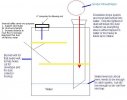- Joined
- Apr 2, 2011
- Messages
- 425
So I've been playing with this idea in my head for awhile and made a what I'll call proof of concept. It sucks air passively and stronger once I turn on the shop vac. It bubbles when in "passive filtration mode" and swirls . I'm pretty sure that I'm getting "clean dust free air" when I turn on the shop vac . I've been tweaking water levels attachments to the tubes and what not . Now I've decided to down scale it to a 5 gallon pail which should up the rate of suction and be able to have more water for filtration. Here is a diagram of what I will be building in the next few days and for humor purposes 2 pics of the original. I guess there is commercial products for drywall dust out there but this was all my idea.

Now the funny part , I'm well aware that the 120 cfm bathroom fan will get destroyed but I'm using what I have on hand right now , the small shop vac was on sale for $20 . I like duct tape as you can see.


Hopefully the next one will be much better. I think the concept is good though.

Now the funny part , I'm well aware that the 120 cfm bathroom fan will get destroyed but I'm using what I have on hand right now , the small shop vac was on sale for $20 . I like duct tape as you can see.


Hopefully the next one will be much better. I think the concept is good though.

